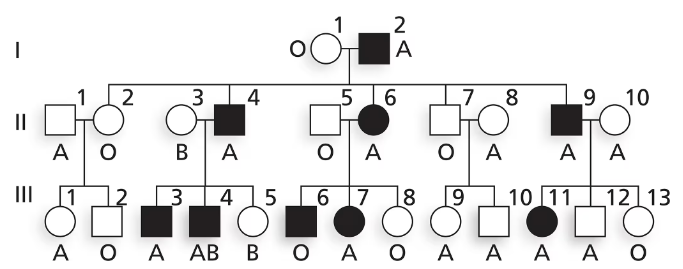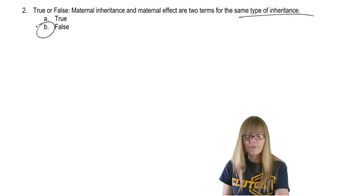A couple comes into your genetic counseling practice with a question about the chance a future child of theirs might have a genetic disease. Three or four men in the woman's family, including her father, had a condition that might be genetic. Although her father is still alive, she has had little contact with him for much of her life and cannot describe or name the condition. Her partner is a healthy man whose family has no history indicating the presence of a genetic condition. To provide more information about this possible genetic condition for the couple, what is the first step you recommend?
Table of contents
- 1. Introduction to Genetics51m
- 2. Mendel's Laws of Inheritance3h 37m
- 3. Extensions to Mendelian Inheritance2h 41m
- 4. Genetic Mapping and Linkage2h 28m
- 5. Genetics of Bacteria and Viruses1h 21m
- 6. Chromosomal Variation1h 48m
- 7. DNA and Chromosome Structure56m
- 8. DNA Replication1h 10m
- 9. Mitosis and Meiosis1h 34m
- 10. Transcription1h 0m
- 11. Translation58m
- 12. Gene Regulation in Prokaryotes1h 19m
- 13. Gene Regulation in Eukaryotes44m
- 14. Genetic Control of Development44m
- 15. Genomes and Genomics1h 50m
- 16. Transposable Elements47m
- 17. Mutation, Repair, and Recombination1h 6m
- 18. Molecular Genetic Tools19m
- 19. Cancer Genetics29m
- 20. Quantitative Genetics1h 26m
- 21. Population Genetics50m
- 22. Evolutionary Genetics29m
2. Mendel's Laws of Inheritance
Pedigrees
Problem 14a
Textbook Question
Nail–patella syndrome is an autosomal disorder affecting the shape of nails on fingers and toes as well as the structure of kneecaps. The pedigree below shows the transmission of nail–patella syndrome in a family along with ABO blood type. Is nail–patella syndrome a dominant or a recessive condition?

Is nail–patella syndrome a dominant or a recessive condition? Explain your reasoning.
 Verified step by step guidance
Verified step by step guidance1
Step 1: Understand the inheritance patterns of dominant and recessive traits. A dominant trait requires only one copy of the allele to be expressed, while a recessive trait requires two copies of the allele to manifest in an individual.
Step 2: Examine the pedigree provided in the problem. Look for patterns of inheritance across generations. Specifically, check if the condition appears in every generation (indicative of dominance) or skips generations (indicative of recessiveness).
Step 3: Identify whether affected individuals have at least one affected parent. If affected individuals consistently have at least one affected parent, this supports the condition being dominant.
Step 4: Analyze unaffected individuals in the pedigree. If unaffected individuals do not pass the condition to their offspring, this further supports dominance, as recessive conditions can be carried silently by heterozygous individuals.
Step 5: Consider additional evidence, such as the co-occurrence of nail–patella syndrome with ABO blood type, to ensure the inheritance pattern aligns with the dominant trait hypothesis. Use this reasoning to conclude whether the condition is dominant or recessive.
 Verified video answer for a similar problem:
Verified video answer for a similar problem:This video solution was recommended by our tutors as helpful for the problem above
Video duration:
2mPlay a video:
Was this helpful?
Key Concepts
Here are the essential concepts you must grasp in order to answer the question correctly.
Autosomal Dominance and Recessiveness
Autosomal dominance and recessiveness refer to how traits are inherited through genes located on non-sex chromosomes. In dominant conditions, only one copy of the mutated gene is needed for the trait to manifest, while in recessive conditions, two copies are required. Understanding these inheritance patterns is crucial for analyzing genetic disorders like nail–patella syndrome.
Recommended video:
Guided course

Variations on Dominance
Pedigree Analysis
Pedigree analysis is a method used to trace the inheritance of traits through generations in a family. By examining the pedigree, one can determine how a genetic condition is passed down, identifying affected individuals and their relationships. This analysis helps in deducing whether a condition is dominant or recessive based on the presence or absence of the trait in family members.
Recommended video:
Guided course

Pedigree Flowchart
ABO Blood Type Inheritance
The ABO blood type system is an example of codominance and multiple alleles, where individuals can inherit one of four blood types (A, B, AB, or O) based on the alleles they receive from their parents. Understanding this system can provide insights into genetic inheritance patterns and help differentiate between traits that are inherited independently versus those that may be linked to other genetic conditions, such as nail–patella syndrome.
Recommended video:
Guided course

Types of Maternal Inheritance
Related Videos
Related Practice
Textbook Question
374
views


